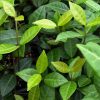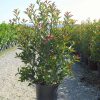In the month of August watering becomes one of the most important maintenance issues. If there is not enough rainfall then it is up to us to provide the water needed to keep all of our landscape investments alive. Water your plants early in the day and by soaking them deeply and infrequently you will encourage a deep, healthy root system.
Let your lawn grasses grow a little taller this time of year- not only will it help to shade the other leaf blades, it will require less water and help reduce any heat stress and therefor require less irrigation.
Continue to begin to plant any fall vegetable that you may want. If you have not done so, now would be a good time to top dress or work some new compost into any new or existing beds.
If you have any perennials that are starting to look a little stressed now would be a good time to cut these plants back. This will help to keep them from getting leggy, and will also help to get them to flush back out for a nice fall presentation. Also prune any shrub that may be getting overgrown.
When working in the yard- don’t forget to wear sun protection during the hot summer, this includes sunscreen and a hat to help shade your head from the harmful rays of the sun.
You can give new plantings a little shade this time of year by using lean-too shade structures or using shade cloth. You can use landscape fabric or sheets from the house to provide temporary shade for the young tender plants until they are ready to tolerate the heat or until temperatures are cooler.
Move plants that are in containers away from direct sunlight during the hottest hours of the day, this will help them to stay cool and help reduce the amount of water that they will require.
Don’t forget to water, water, water.
Continue to dead head your annual color plants, this will help keep them blooming through out the summer months. Seed heads will reduce the amount of color they will provide during this time.
Our soils lack enough Iron (Fe), a good application of Iron (Fe) will help our lawn grasses to green up.
Watch for insects on trees, shrubs, and also look for fungus on turf grasses, this can cause them to turn yellow and eventually die.



